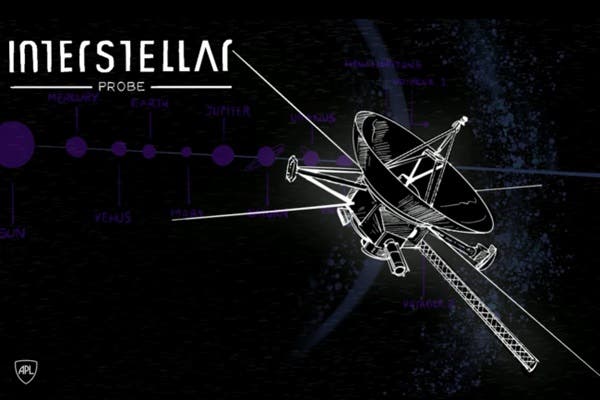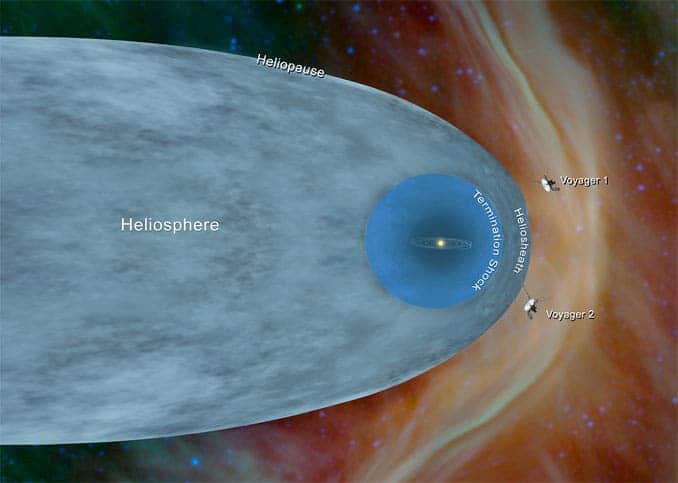
When the famous Voyager twin spacecraft left Earth in the 1970s, their mission was originally meant to last only five years. However, the plutonium-powered spacecraft were still going strong when they reached Jupiter and Saturn, so NASA engineers decided they would try a flyby of Uranus and Neptune. But, even after that, the spacecraft still kept going and going — and they’re still at it almost 50 years later. So much so that both probes made history by officially exiting the bubble-shaped region created by the sun’s wind, known as the heliosphere, crossing into interstellar space.
Although they’re 14 billion and 11 billion miles, respectively, away from Earth, Voyager 1 and Voyager 2 are continuing to provide invaluable scientific data. For instance, sensors on the spacecraft are recording important information about the composition and levels of the gas, dust, and radiation that fills interstellar space — which is anything but empty, contrary to popular belief. This wouldn’t have been possible without these two daring spacecraft.
However, the Voyager twins can’t go on forever. Scientists estimate that the last instruments onboard the spacecraft will shut down by 2031 at the latest, if some malfunction doesn’t happen before then. This is why NASA wants a replacement — and this time, this new interstellar mission will be designed to run for a long time from the get-go. In fact, scientists at the Johns Hopkins University Applied Physics Laboratory (APL) who have been tasked with designing the new mission, believe this Voyager successor could function for more than a century.
Our new beacon in interstellar space
The new project, known as the Interstellar Probe, could launch sometime in the 2030s. It’s meant to travel faster and farther than any man made object has and probably ever will in the foreseeable future. While still in the solar system, the plan is for the spacecraft to visit one or more of the 130 known dwarf planets in the outer reaches of the solar system. There are some clues that some of these icy worlds may have formed as ocean worlds.
“The Interstellar Probe will go to the unknown local interstellar space, where humanity has never reached before,” said Elena Provornikova, the Interstellar Probe heliophysics lead at APL “For the first time, we will take a picture of our vast heliosphere from the outside to see what our solar system home looks like.”
According to early design projections, the Interstellar Probe should travel at a speed at least twice as fast as Voyager 1, which should help it travel about 375 astronomical units (34 billion miles) in its first 50 years. If it manages to travel another 50 years, the spacecraft could end up covering more than 800 astronomical units, which amount to a staggering 74 billion miles.

Though impressive, that distance isn’t actually a lot by astronomical standards. Bear in mind that Proxima Centauri, the closest star to our solar system, is about 25 trillion miles away. It would probably take more than 30,000 years to reach Proxima Centauri with our current tech — that’s how far behind we are from the feats casually imagined in science fiction and popular media. You gotta start somewhere though, which is why NASA wants a continued presence in interstellar space.
The long game
Interstellar missions are a different beast from anything NASA or any other space agency for that matter has attempted before. It’s not that they’re necessarily more technically challenging than landing an astronaut on the moon or operating a rover on Mars — it’s just that their timescale is so large, they will outlive the original members of the mission.

This brings with it a novel suite of challenges that come with passing the baton to a new generation of scientists. The mission will also have to somehow safely store hardware spare parts, as well as the software they code now so that engineers have the debugging tools required to solve a possible malfunction even a hundred years from now. You gotta think ahead, and that may involve imagining the unthinkable.
“We do need to learn how to conduct missions over these very long timescales if we are ever going to come close to achieving any of the aspirations of interstellar exploration that are so often posed in the popular media,” Stella Ocker, a graduate student at Cornell University who works with Voyager data, told NPR in a recent feature story on the Interstellar Probe’s mission.
Although the proposed mission is still in its planning phase, with an estimated cost of around $1.5 billion, scientists hope to attach some new easter eggs. Each Voyager spacecraft was mounted with a ‘Golden Record’ on the off chance these would be encountered by an intelligent alien race. Each record conveys sounds, images, and greetings from the people of planet Earth. The audio recording ranged from the sound of rain to samples of Beethoven and Mozart, Chuck Berry, and Blind Willie Johnson.
“I don’t think we should try to copy the Golden Record,” Ocker said, “but I think it would be really amazing to have a similar kind of public outreach piece that plays an important part in the mission.”









